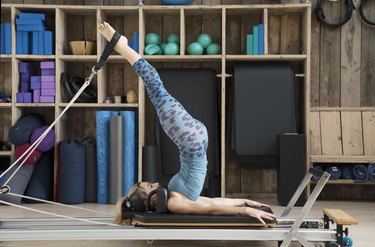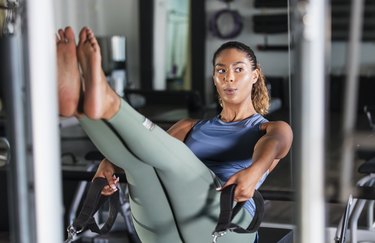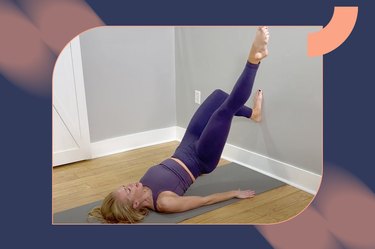
From classical and mat Pilates to reformer and Stott Pilates, it might seem like there are as many different types of Pilates as there are exercises to master. It can be confusing if you're new to the fitness world or looking to dive into a workout you've never tried before. What's the difference between all these types? And which one should you try?
No matter what kind of Pilates class you find yourself in, the workouts all rely on the core principles of breathing, control, centering and flow. The differences lie primarily in the different ways to perform Pilates, such as on a mat or using a reformer machine. There are also many influential Pilates teachers, including Moira Merrithew and Mari Winsor, who've added their own style and elements to Pilates.
Video of the Day
Video of the Day
That doesn't even begin to cover the many hybrid types of Pilates incorporating yoga, barre, boxing and more that are rapidly growing. Since the options are many, here's how to know what to look for.
Which Pilates Workout Is Right For You?
The type of Pilates that's best for you depends on what your goals and personal preferences are. Pilates is great for overall strengthening and fitness, but there are many other reasons people benefit from certain types of Pilates.
Looking to ease back, neck or other joint discomfort? A January 2018 review in the Journal of Bodywork and Movement Therapies found classical Pilates to be an effective tool to manage a variety of types of pain, including chronic neck and back pain.
If the goal is adding lean muscle to aid weight loss, you'll want the Pilates workout that burns the most calories. While that often depends on your effort or the intensity of the individual class, Christina Pabon, Peak Pilates Comprehensive certified instructor for Life Time Athletic in Columbia, Maryland, recommends reformer classes or Stott Pilates Jumpboard classes, which incorporate a jumpboard at the base of the reformer.
Maybe your goal is to relieve stress through your workout and you want a more private session where the focus is on mindfulness instead of machines and equipment, such as what's offered in a semi-private classical Pilates class. The key is to make your Pilates workout part of an overall health and fitness plan, no matter which type you choose.
To help you decide the one that's right for you, here are six types of Pilates and what you need to know about each of them.
1. Classical Pilates
Classical Pilates follows the original system Joseph Pilates created in the 1920s and incorporates both mat and apparatus work. "Classical varies from other forms of Pilates, because it means that I teach in a traditional order, which includes transitions between exercises," Pabon says. That makes this type of Pilates good for practitioners who thrive on structure and predictability in their workouts.
Another important distinction between classical Pilates and other types is the resting position. Classical Pilates focuses on more of a posterior pelvic tilt (hips tilt toward your back), as well as a few other postural preferences at the head, neck and shoulders, says physical therapist Christine Pieton, owner of Pieton Physical Therapy and Pilates.
Read more: 19 Ab-Sculpting Pilates Moves You Can Do At Home
2. Mat Pilates
The exercises in mat Pilates are performed with your body and a yoga mat in lieu of machines and equipment. Mat Pilates focuses on your core, making it beneficial for those with back pain. The movements in mat Pilates are based on the mat exercises in the classical Pilates system.
An April 2014 study in the Journal of Physical Therapy Science compared mat Pilates and apparatus Pilates (like reformer Pilates) and found the group performing mat Pilates showed greater improvement in both pain level and balance.
3. Reformer Pilates
This type of Pilates offers similar core-strengthening benefits of mat Pilates, but uses a reformer, a machine with a bed-like frame, a platform and a set of springs. Many of the exercises on the reformer are the same as mat exercises but performed with the added resistance of the reformer's springs, straps and ropes.
Ultimately, you can better customize fitness goals such as improving postural alignment and coordination than you can with mat Pilates. "The advanced form of reformer allows students to flow from one exercise to next with transitions," Pabon says. "This enables constant movement and burns more calories."
Since reformer Pilates classes tend to be more intense than mat classes, they might be the better choice for those already well-versed in mat Pilates and are looking to burn more calories and lose weight.
Read more: A Pilates Instructor's Secrets to Long, Lean Legs
4. Contemporary Pilates
Though contemporary Pilates is inspired by and based on the classical system of Pilates, each class varies depending on the type of school that each Pilates instructor goes through and what style they prefer to teach, Pieton says.
"I, for example, went through Balanced Body's program, which has a contemporary versus classical focus and supports teachers being able to use Pilates for movement re-education," she says. "This is also helpful for me being a physical therapist who uses my Pilates education for rehab and movement re-education with my clients."
These exercises are typically based on contemporary research. Polestar, for example, is a contemporary approach "shaped by concepts from biomechanics, motor learning, communication skills, current research to enhance the work of Joseph Pilates," according to the Polestar Pilates website.
As the experience will vary widely from instructor to instructor, those new to Pilates (or who've tried another type before and not been a fan) may find it less intimidating to begin working out in a less traditional way.
5. Stott Pilates
Stott Pilates creator ballerina Moira Merrithew originally studied Pilates after a neck injury. Central to this form of Pilates is the incorporation of expertise from rehabilitation experts and movement specialists, Pieton says. For example, each class begins with a warm-up to align the body and release neck and back pressure.
Another thing that sets this type of Pilates apart is that it takes the basic principles of the classical method and adds props such as the stability ball, foam roller and BOSU, making it a good pick for anyone looking to improve their balance. And unlike classical Pilates where the lower spine is pressed into the floor, in Stott Pilates, you maintain the natural curve of the lower spine off the floor.
6. Winsor Pilates
Renowned Pilates instructor Mari Winsor popularized her Winsor Pilates method with workout videos and infomercials. The Winsor Pilates fitness videos focus on weight loss and shaping the body with a combination of classical Pilates exercises done in a specific, nontraditional order to maximize results.
Winsor Pilates' consists of 13 Pilates mat movements, including the Hundred, the Roll-Up and the Single Leg Circle, in 20-minute workouts, making it ideal for beginners and those who are short on time.


